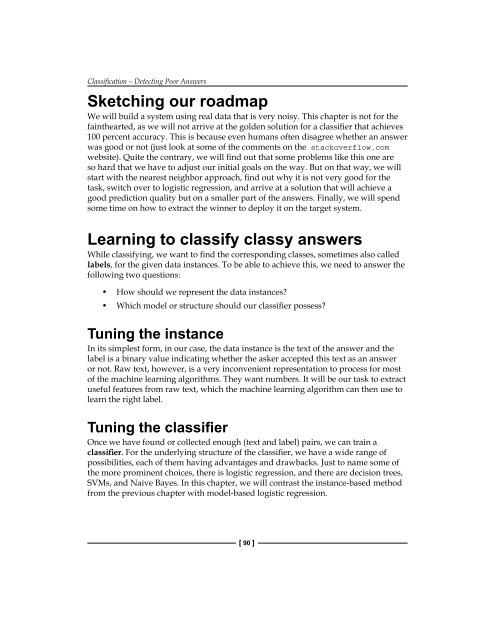1FfUrl0
1FfUrl0
1FfUrl0
Create successful ePaper yourself
Turn your PDF publications into a flip-book with our unique Google optimized e-Paper software.
Classification – Detecting Poor Answers<br />
Sketching our roadmap<br />
We will build a system using real data that is very noisy. This chapter is not for the<br />
fainthearted, as we will not arrive at the golden solution for a classifier that achieves<br />
100 percent accuracy. This is because even humans often disagree whether an answer<br />
was good or not (just look at some of the comments on the stackoverflow.com<br />
website). Quite the contrary, we will find out that some problems like this one are<br />
so hard that we have to adjust our initial goals on the way. But on that way, we will<br />
start with the nearest neighbor approach, find out why it is not very good for the<br />
task, switch over to logistic regression, and arrive at a solution that will achieve a<br />
good prediction quality but on a smaller part of the answers. Finally, we will spend<br />
some time on how to extract the winner to deploy it on the target system.<br />
Learning to classify classy answers<br />
While classifying, we want to find the corresponding classes, sometimes also called<br />
labels, for the given data instances. To be able to achieve this, we need to answer the<br />
following two questions:<br />
• How should we represent the data instances?<br />
• Which model or structure should our classifier possess?<br />
Tuning the instance<br />
In its simplest form, in our case, the data instance is the text of the answer and the<br />
label is a binary value indicating whether the asker accepted this text as an answer<br />
or not. Raw text, however, is a very inconvenient representation to process for most<br />
of the machine learning algorithms. They want numbers. It will be our task to extract<br />
useful features from raw text, which the machine learning algorithm can then use to<br />
learn the right label.<br />
Tuning the classifier<br />
Once we have found or collected enough (text and label) pairs, we can train a<br />
classifier. For the underlying structure of the classifier, we have a wide range of<br />
possibilities, each of them having advantages and drawbacks. Just to name some of<br />
the more prominent choices, there is logistic regression, and there are decision trees,<br />
SVMs, and Naive Bayes. In this chapter, we will contrast the instance-based method<br />
from the previous chapter with model-based logistic regression.<br />
[ 90 ]


